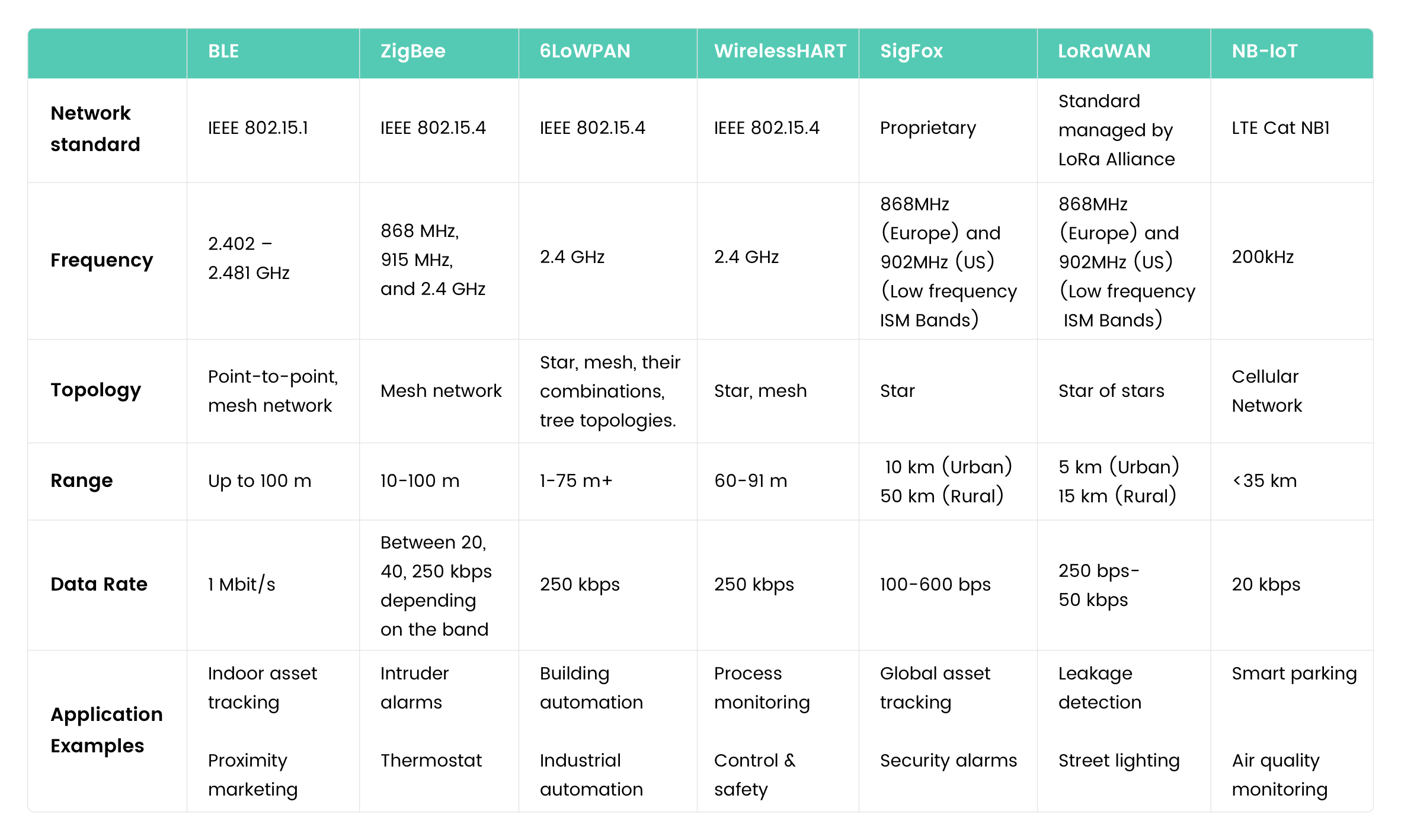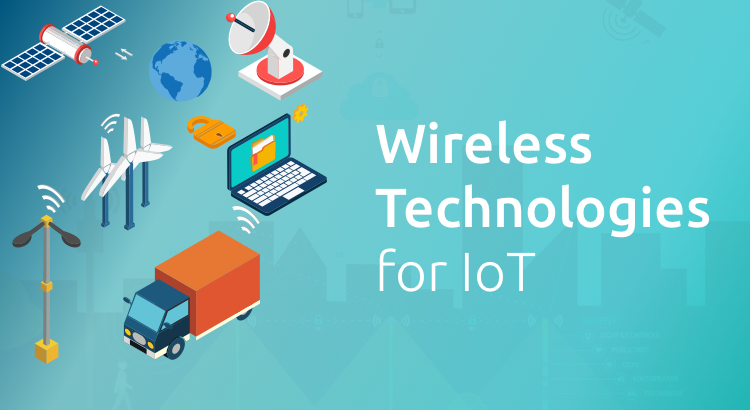The Internet of Things would not be the exciting prospect that it is without a key component – wireless technologies. These technologies are defined under various standards and protocols and choosing the right one depends on the context and the requirement.
Some IoT implementations require data to be transmitted over long distances, others short; some devices transfer small volumes of data, others large. Some are deployed in inaccessible environment and their life needs to be sustained longer. This diversity in requirements and devices necessitates different communication standards and protocols in different contexts.
The protocols can be analyzed broadly based on bandwidth (how much data can be transmitted in unit time), power requirements of transmission devices, and coverage. Besides these technical attributes, other aspects such as spectrum license, royalty expenses, compatibility with existing infrastructure (for example, cellular) also determine the selection of wireless communication technologies for IoT applications.
Bluetooth Low Energy (BLE)
Bluetooth Low Energy (BLE) is a highly optimized extension of the classical Bluetooth standard and is designed to transmit small packets of data consuming very low power at very low cost. It operates on the 2.4 GHz Industrial Scientific Medical band and has two types of RF channels: one for device discovery and transmission and the other for two-way communication between devices.
BLE has seen wide adoption largely owing to its highly adaptable framework, which makes it ideal in a variety of contexts. BLE optimizes power usage by staying in sleep mode most of the time. Even when it is active, it draws low peak current and thus BLE devices can run on button cell battery for more than a year. A lean protocol stack and real-time transmission are other factors that have contributed to the uptake in BLE-based operations.
Design Considerations: Applications (mostly indoor short-range applications) that require higher data transfer rates and integration with smartphone as potential reception devices.
Application Examples: Indoor positioning and tracking, smart home/car locks, device monitoring, proximity marketing, health and fitness, and so on.
ZigBee or IEEE 802.15.4
ZigBee is a low data rate wireless networking standard for creating wireless personal area network (WPAN). It derives its name from the mesh topology which it supports – that is, it connects every device to the other ensuring that the data from each node flows to its destination through one channel or other. This topology makes it suitable for implementations where a large number of sensors are involved and redundancy is a priority.
Depending on the band in which it operates (2.4 GHz, 868 MHz, and 915 MHz), its data rates are 250 Kbps, 40 Kbps and 20 Kbps respectively. ZigBee’s benefits are low cost, low power consumption (the battery lasts years), and flexible design. Because of its low data rate, it is better suited for low-latency applications and because of its short coverage of 10-100m, it is suited for indoor communication.
Design Considerations: Lower bandwidth indoor applications that demand high availability and fault tolerance.
Application Examples: Remote control of home appliances, low latency devices such as on/off light switch, thermostat, intruder alarms, and in-home patient monitoring systems.
6LoWPAN
This technology uses the latest Internet protocol, IPv6, to transmit small packets of data over Low Power Wireless Personal Area Networks (LoWPAN). 6LoWPAN is the result of an initiative to enable even the tiniest of devices to connect to the Internet and be part of the Internet of Things.
Compared to ZigBee, which requires a more complex gateway to connect with other networks, 6LoWPAN provides good interoperability with other 802.15.4 devices as well as other IP-based systems with a simple bridge device. Being able to connect to a wide range of applications using IP communication is also pushing its adoption in the IoT market. Topologies supported by 6LoWPAN includes star, mesh, their combinations, and tree topologies. A 6LoWPAN wireless network is usually used to connect low cost and low power devices.
Design Considerations: Lower bandwidth indoor applications that provide high availability and fault tolerance and allow easier integration with IPv6, the open protocol to replace Zigbee.
Application Examples: Home automation, industrial automation, low latency devices such as on/off light switch, thermostat, smart metering, asset management systems, and so on.
WirelessHART
WirelessHART is a communication standard used for industrial process automation applications. It has tremendously improved the collection of process data, which is required as part of process improvements as well as security and regulatory requirements. As a mesh network protocol, WirelessHART supports different topologies including complex mesh networks.
Apart from transmitting their own data, the devices in the mesh network can relay messages for other nodes and disseminate data through the network. This allows for more reliability in industrial process control and maintenance-related applications. Other benefits of WirelessHART include multipath routing, interoperability, and reliability. Since HART has been in existence for a long time and has a wide installation base, an extension to WirelessHART is not only less expensive but also relatively simple.
Design Considerations: Integration with HART protocol (the proven industrial automation protocol) and high interoperability.
Applications: Process and condition monitoring (for example, renewable energy farm), control and safety applications.
SigFox
SigFox is a lightweight protocol, which leverages the 200 kHz public band to send very small messages. The ultra narrowband modulation used in SigFox helps enhance the network capacity at low power. While 40 bytes would be required to transport 12 bytes messages in a conventional wireless system, SigFox requires only 26 bytes. This means more space for messages and more network capacity. In its one-way communication, SigFox transmits the same message many times to ensure reliability. Each retransmission can drive up its energy usage.
SigFox is best suited for contexts where a small data volume is to be sent over long distances with very little environmental noise impact. Apart from defining the protocol, SigFox has established a network that covers nearly 45 countries across the world. Any SigFox device can get connected to this network and send messages to SigFox cloud. Messages can be easily captured and published online. So SigFox is not just a protocol, but also a service.
Design Considerations: Very low power communication, long range, very low data rate, easily accessible global network, single vendor, ready integration with cloud.
Applications: Logistics, global asset tracking, remote monitoring, and smart cities.
LoRaWAN
Another type of LPWAN technology is LoRaWAN, which offers a higher bandwidth than Sigfox. It is also energy efficient and can be implemented at a very low cost to transmit data packages over long distances and in remote areas. The modulation technique in LoRaWAN is simpler to implement, which further helps reduce the cost. Its star architecture allows connections to be established with a number of devices. The application server can be connected to several gateways, which are connected to several end devices.
There are three classes of LoRaWAN end devices: A, B, and C. All three classes support two-way communication between the device and gateway but differ in their number of receive windows. Class C devices have the maximum receive windows, which remain open at all times except during uplink transmission. Hence these draw more energy than A or B.
Design Considerations: Very low power communication, long range, very low data rate, multiple vendor solutions, distributed gateways by independent groups.
Applications: Location tracking, smart meters, leakage detection, and street lighting.
Narrowband IoT (NB-IoT)
Narrowband IoT is a low-power wide area technology standardized by 3GPP for low power, low-cost IoT devices and optimized for long-range connections. The objective of the standard is to the address needs of the IoT segment within LTE standards for wireless mobile networks. With a data rate of 200 Kbps, which is at least 20 dB over GSM networks, and thousands of connections possible at every base station, NB-IoT technology is being eyed by a number of mobile service providers who would like to extend their service to IoT.
NB-IoT can be used as a standalone technology or by using unused resource blocks within an LTE carrier’s guard-band. Large number of connections, flexible transmission, high power efficiency, deep penetration, low-cost components, extensive coverage (5 km in urban, 50 km in rural), and high reliability make it one of the exciting standards to emerge in the light of IoT.
Design Considerations: Very low power communication, long range, very low data rate, integration with cellular mobile network.
Applications: Asset tracking, smart metering, parking, air quality monitoring, and any other low data rate application within mobile coverage.
A Comparison of Wireless Protocols for IoT




